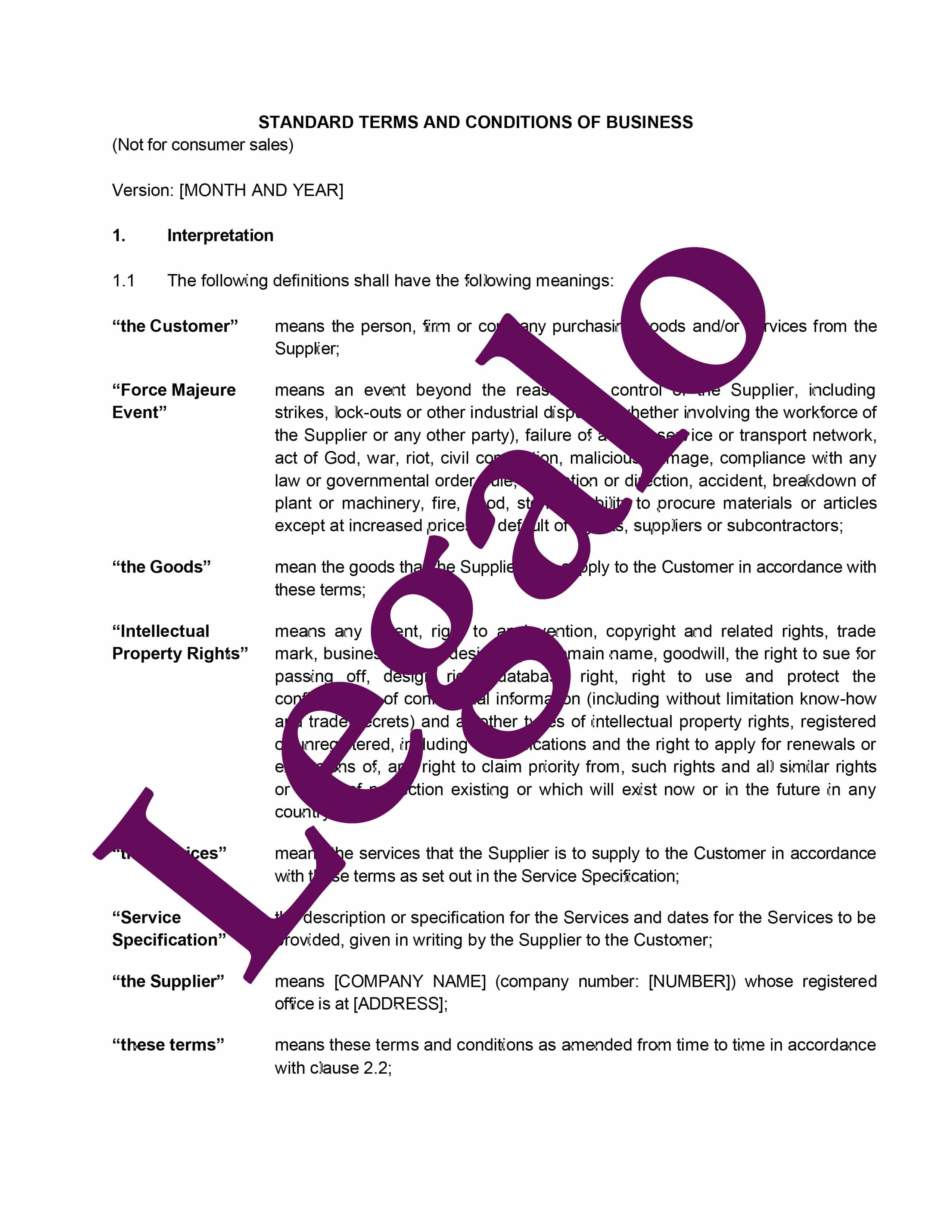Terms and Conditions of Sale – B2B – Goods and Services
Our terms and conditions:
- money-back guarantee
- drafted by an expert UK lawyer
- for sales to other businesses – not consumers
- for sales of goods and services or just services

How Does It Work?
-
1. Download
-
2. Edit
-
3. Print
-
4. Sign
MD, Legalo Ltd; Solicitor; Notary Public
Our Terms and Conditions of Sale template is for use if you sell goods and services or just services to other businesses (not to consumers).
These terms can be used whether:
1. you sell via a retail or trade outlet; or
2. you sell via your website.
If you sell only goods and do not supply any services (e.g. installation of the goods sold), other than shipping and insurance of the goods, then see our other Terms and Conditions of Sale template for B2B sales of goods. Where you sell to consumers, then see our other Website Terms and Conditions templates for sales of goods to consumers or sale of goods and services to consumers.
If you sell via the Internet, then, in addition to these terms that govern the contract for the sale of goods and services, you may also need our templates for:
Consumer protection
When selling only to other businesses, you can have more robust or harsh terms than you would be permitted to have if you were dealing with consumers. This is due to the extensive consumer protection rules that apply to protect consumers. This version of our various templates for terms and conditions is only suitable for sales to other businesses.
Distance selling
There are no special terms that apply to sales from one business to another business if you contract online or via telephone (distance sales). This is in marked contrast to when you sell to a consumer.
Using these terms and conditions
To use these terms effectively, you must ensure that a copy of your terms is:
- sent to the customer in each case, or
- seen by them (or agreed to by them) on your website, before the sale contract is agreed or concluded.
For example, you can put them on the back of your quotation forms. This is fine, because a quotation would be sent before the contract is concluded. However, you should not send them out on the back of your invoices, as that will be issued after the contract has been concluded. It is therefore too late to send the terms at that stage.
For repeat orders, so long as you have sent your terms once to the customer or they agreed to them in the past via your website, then you do not have to re-send them every time the customer places an order. If you do not make the customer aware of your terms, then they do not form the basis of the contract and are irrelevant. Under English law, the customer does not need to have read the terms for the terms to be binding.
If you update the terms, then you need to get the new version to your existing customers in some way. For example:
- by post,
- by email, or
- by their agreeing to the terms again when they place their next repeat order via your website.
If you don’t do this, the contract will still be on the basis of the old terms for existing customers.
Should you get the customer to sign the terms?
For important contracts (e.g. large orders), it can be useful to get your customers to sign the terms or a letter, etc that specifically refers to their accepting that your terms are agreed to or are the basis of the contract or order. You should then keep a copy on file. For normal run-of-the-mill orders, it is not generally necessary for each customer to sign the terms and then for you to hold them on file, but you must be able to prove you gave them the terms before you formed the contract.
“Battle of the forms”
If your customer has their own terms of purchase (e.g. on their purchase order) and insists their terms are the basis of the contract, then you have a battle over which set of terms applies. The rules are that the last set sent before you form the contract will be the terms that apply to the contract. In basic contract law terms, you form a contract when you have an offer and an acceptance of it.
Printing these terms and conditions
If you are planning on printing these terms on the back of your quotation forms, once you have finalised the draft, then reduce the margins, paragraph spacing and font size to suit your needs and try putting them into 2 columns. You should be able to get them onto one A4 page with some extreme adjustments (you may need a font size of about “5”).
Guide to the Terms and Conditions Template
For the majority of the text to the guide to the template, please see the page on our similar template: “Terms and Conditions of Sale – B2B – Goods Only“.
Please note the following key differences:
1. Interpretation
This includes definitions of “Services” and “Service Specification”.
4. Services
This additional clause covers the supply of the Services. Clause 4.2 gives the supplier some flexibility as to the timing of the supply of the services.
Clauses 4 to 15 in the other guide are then renumbered as clauses 5 to 16 to suit this template.
5. Price
Clause 5.3 sets out when you will invoice for the goods and services – allowing invoices at different times. Please check this is what you want or adjust it to suit (completing the intervals in clause 5.3.2). The last sentence of clause 5.4 says that you may charge extra for the services if the customer requests your workers work overtime.
10. Warranties (sale of goods and services)
This clause in the terms and conditions sets out the warranty given by the supplier for the goods and services. The warranty you are giving for the services is in clause 10.2. Complete the warranty claim deadlines in clause 10.2.1.
11. Limitation of Liability and Customer’s obligations
This clause seeks to limit or exclude the supplier’s liability in case something has gone wrong (subject to the warranties under clause 10). If you are not installing any goods, then delete the words in square brackets on line 4 of clause 11.1. Clauses 11.3 and 11.4 require the customer to ensure any premises (i.e. those of the customer or the customer’s client) that the supplier is working in or on are safe.
16. Intellectual Property Rights
Clause 16.3 states that the supplier remains the owner of any intellectual property in the services. For example, copyright in designs and plans. This ensures that the supplier is free to supply similarly designed services to other of its customers in the future. The designs are not exclusive to the customer.



